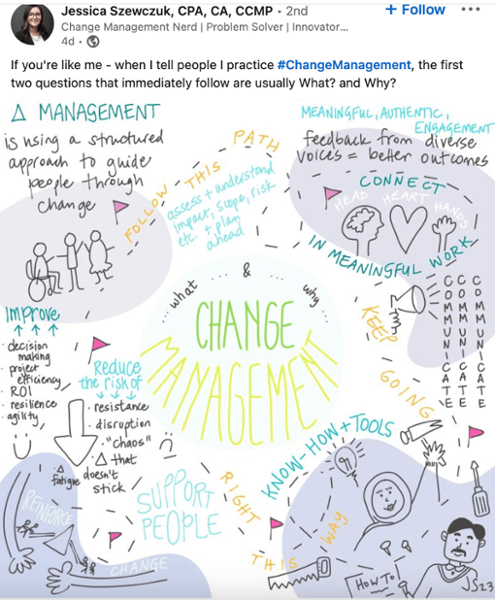Integrate Organization Development And Change Management
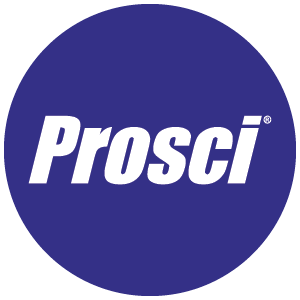
10 Mins
Updated: February 4, 2025
Published: December 11, 2023

The business world is dynamic—integrating organization development (OD) and change management (CM) is key to navigating change and driving growth.
OD establishes a resilient foundation, while CM prepares individuals to adapt effectively. Together, they enable strategic shifts essential for a company's progress and durability.
Here, we’ll explore the unique value of organization development and change management, offering practical roadmaps and resources to better understand their combined power for your company's success.
What Is Organization Development (OD)?
An organization's development bridges strategy and action by drawing insights from organizational science and psychology.
OD aligns organization goals with employee needs so that CM can guide implementation effectively. Its strategic focus lays the foundation for a symbiotic relationship with CM.
For example:
- OD assesses reporting structures and policies when a retail company expands into e-commerce.
- OD helps develop an integration strategy and optimize organizational structure when an airline purchases a regional carrier,
Key aspects of OD include:
- Adaptability – OD optimizes systems and relationships to navigate change effectively.
- Humanistic values – Prioritizes fair treatment, participation, and personal growth.
- Trend awareness – Considers current societal and industry trends for informed decision-making.
- Stakeholder insight – Identifies and assesses the influence of key stakeholders.
- Customization – Tailors strategies using the latest data to fit each company uniquely.
- Agility – Promotes a dynamic work environment for strategic advancement.
- Purpose-driven – Align your company’s actions with employee satisfaction and overall objectives for a harmonious and productive workplace.
Use Organization Development (OD) to align your business strategies with team needs, making your company more adaptable and focused on employee growth. This approach drives your business forward with purpose and resilience.
What Is Change Management and Why Is it a Crucial Competency?
Change is inevitable for growth, yet organizational change is complex, affecting numerous stakeholders.
CM's practical tools and methods support OD's big plans, ensuring changes are well-prepared, carried out smoothly, and accepted by the team.
People are often considered an organization's most valuable asset. Individuals make organizational changes successful, hence the need for strategic change management.
Change Management (CM) provides a set of:
- Tools
- Processes
- Techniques
All of these guide employees through organizational changes. The aim is to minimize stress and resistance while helping everyone embrace new changes more quickly and effectively.
Prosci research indicates projects with excellent change management are seven times more likely to succeed than those with poor or no change management.
Think of these scenarios:
- When an airline buys a smaller regional company, OD helps plan how to combine the two and streamline its operations.
- When a retail company moves into online sales, OD examines and adjusts how information flows and rules are set.
Change management goes beyond communicating changes—it actively supports individuals through these transitions.
Change affects teams differently. For example, introducing a new expense reporting platform can affect the finance, field sales, and procurement teams differently.
Prosci 10 Aspects of Change Impact model
The Prosci 10 Aspects of Change Impact model considers the impact on an individual in their job during significant organizational changes. These are as follows:
- Processes – Changes in how things are done within the organization
- Systems – Introduction or modification of technology or systems used in daily work
- Tools – Changes in the tools employees use to do their jobs
- Job roles – Changes to an employee's role and responsibilities
- Critical behaviors – Behaviors expected from employees to support the change
- Mindsets/attitudes/beliefs – Changes in how employees think about or approach their work and the organization
- Reporting structure – Modifications in the organizational hierarchy or reporting lines
- Performance reviews – Revisions to how you evaluate and provide feedback on employee performance.
- Compensation – Adjustments in salary, bonuses, or other employee perks
- Location – Changes in the physical workspace or location from where employees work
Prosci 10 Aspects of Change Impact
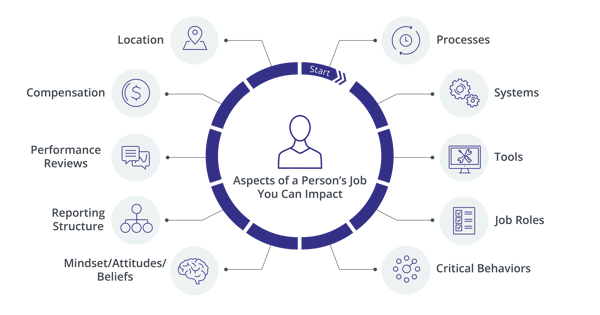
Effective change management, rather than rushed changes, signifies that employees are truly valued, benefitting the entire organization in outcomes like higher adoption and usage rates, greater ROI for the project or initiative, decreased turnover rates, enhanced productivity, and stakeholder satisfaction.
- At the project level, change management utilizes processes and tools to guide stakeholders to desired outcomes.
- At the organizational level, it builds strategic capabilities and leadership skills to drive transformation.
Effective change management processes boost productivity and retention, fostering lasting organizational success.

Understanding the Relationship Between Organization Development and Change Management
To grasp the relationship between Organization Development (OD) and Change Management (CM), consider OD the architect of change—designing the long-term strategic plan for your company's future. Change Management, on the other hand, is the builder—it takes the architect's designs and turns them into reality, one step at a time.
Here's a straightforward way to put this into practice:
- Map it out – Use OD to create a clear vision and strategy for change within your organization.
- Make it happen – Deploy CM to execute the plan, manage the details, and guide your team through the transition.
Understanding this partnership between OD and CM equips you to manage change more effectively, ensuring that each step is purposeful and contributes to a thriving organizational environment.
OD and CM put people first, which is crucial for successful change.
OD draws up the big plans, making sure the company's goals match its culture and how it works. CM, on the other hand, manages the details, making sure every project and person moves forward without a hitch.
Utilize their combined strength
- Synergize – Blend OD's big-picture planning with CM's detailed execution.
- Focus on people – Keep employee well-being at the forefront of OD and CM strategies.
- Adapt and thrive – Use OD's insights and CM's practicality to stay agile and responsive in a fast-changing business world.
Together, OD and CM form a unified strategy that can enable your organization to survive change and thrive through it.
The table below explains their similarities and differences:
|
Organization Development (OD) |
Change Management (CM) |
|
Similarities |
Both play critical roles in guiding organizational change |
|
|
Both value human dynamics for organizational success |
||
|
Both emphasize the importance of people in organizations and change |
||
|
Both recognize the increased reliance on workforce adaptability amid the pace of change |
||
Differences |
OD takes a broader systemic view |
CM focuses on specific projects |
|
OD aims to improve overall system's functioning |
CM helps individual adaptation to new work methods |
|
|
OD intervenes broadly shaping the organizational components |
CM provides tactical tools and techniques for individuals going through changes |
|
The table below further explains OD and CM's differences and overlap:
|
Organization Development (OD) |
Change Management (CM) |
|
|
Scope of Application |
OD focuses on the bigger picture, emphasizing entire systems while considering personal relations and group dynamics |
CM targets specific projects or initiatives, aiming to achieve set results by encouraging changes in individual behaviors |
|
Focus of Effort |
OD aims to refine the system’s overall functioning |
CM zooms in on helping individual employees adapt to new ways of working |
|
Level of Engagement |
OD designs interventions to shape the broader organizational elements that dictate how the system functions |
CM offers structured methods to support individuals during change, using tools and processes to guide personal transitions during an organizational shift |
"I think that the wall that has been erected between the two is much lower than we actually would have anticipated. And that an attempt to drive separation between the two disciplines is not advantageous for either discipline or for organizations or positive change generally. The complexity of today’s world requires more inclusive and holistic approaches to change, and bringing organization development and change management together is really what delivers that."
—Tim Creasey, Chief Innovation Officer, Prosci
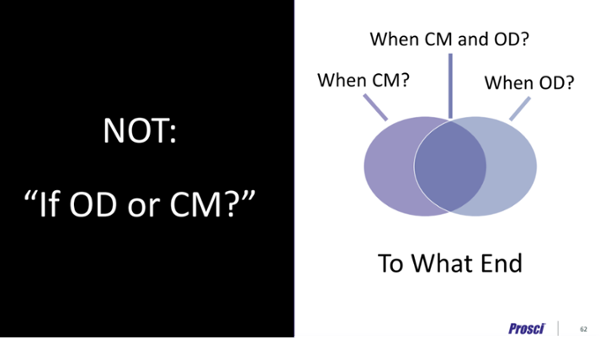
Examples of OD and CM working together
Consider four change examples across industries to see how OD and CM work together.
In this merger, OD's strategic planning in redefining the system’s mission and culture integrates with CM's practical steps, like resistance management and functional training, ensuring a smooth transition for all staff.
1. Healthcare – hospital A and hospital B merger
Hospitals A and B merge to form a new unified health system, combining different organizational cultures, processes and patient populations.
With a clear vision from OD, the merger is more than a blend of policies and processes—it's about people coming together to serve better.
OD's role:
- Redefine strategy and mission for the new integrated health system
- Redesign organization structure and reporting relationships
- Transform culture by bridging differences between hospitals
CM ensures every team member is prepared and equipped to embrace a new direction. They turn your blueprint into a reality.
CM's role:
- Create a detailed change plan and timeline for the merger rollout
- Conduct impact assessment on clinicians, staff, patients and other stakeholders.
- Design communications to inform all impacted groups of changes
- Provide training on new systems, tools and processes
When OD's strategic foresight meets CM's hands-on approach, operations feel natural and well-coordinated.
Overlapping OD and CM:
- Integrate operations, workflows and processes
- Consolidate IT systems and health record management
- Develop new roles to bridge gaps between the hospitals
- Create standard protocols and patient experience
- Foster culture of unified health system vs. individual hospitals
This merger isn't just about growth; it's about creating a healthcare experience where every patient feels at home, no matter the point of care.

2. Technology – Locus software company transitions to cloud-based delivery
Locus software company is transforming to provide cloud-based software-as-a-service (SaaS). This disrupts their traditional business model and operations.
OD's strategy redesign and culture transformation pave the way for Locus's shift to a cloud-based model, setting a solid foundation for change.
OD's role:
- Redefine business strategy for recurring subscription model
- Redesign organizational structure around cloud-based product teams
- Transform culture from traditional software to agile SaaS
CM translates this new strategy into action, ensuring teams are ready and equipped for the cloud transition through detailed planning and training.
CM's role:
- Create a detailed change management plan and timeline
- Conduct impact assessment on sales, delivery and support
- Design communications to inform all impacted teams
- Provide training on selling and supporting the cloud model
OD and CM collaborate with other key functions to integrate systems and roles to transition Locus to a customer-focused, cloud-based delivery.
Overlapping OD and CM:
- Integrate systems for cloud-based software delivery
- Consolidate tools and platforms for distributed teams
- Develop new customer success manager roles
- Create seamless customer onboarding to the cloud
- Foster culture embracing digital delivery and engagement
This transition isn't just about embracing new technology; it's about evolving Locus into a company where innovative cloud solutions enhance every customer's experience.
3. Aviation – Legacy Airline acquires regional carrier
Legacy Airlines's acquisition of Regional Carrier is a strategic move to broaden its domestic reach, blending two distinct company cultures and operations.
To unify these, use OD to chart a strategic course that reshapes and integrates both airlines into a cohesive entity.
OD's role:
- Redefine strategy for integrated airline and network expansion
- Redesign organization structure and reporting lines
- Transform cultures by bridging two airline models
CM ensures smooth integration through detailed planning, communication and training for people impacted by the merger.
CM's role:
- Create a detailed change management plan and timeline
- Conduct impact assessment on roles like flight staff, back-office administration and vendors
- Design communications to inform all impacted groups
- Provide training on harmonized processes and systems
OD and CM work to seamlessly merge operations and systems while building roles and a customer service ethos that reflects the best of both airlines.
Overlapping OD and CM:
- Integrate operations, maintenance procedures and protocols
- Consolidate scheduling systems and crew management
- Develop new pilot and flight attendant roles
- Create consistent customer service experience
- Foster unified airline culture
This merger is more than just adding more flights. It's about building an airline that combines the best of both Legacy and Regional to make every trip better for passengers.
4. Retail – National Retail Store expands to e-commerce sales
National Retail Store is launching a new e-commerce sales channel, requiring organizational systems, processes and culture changes.
OD redefines National Retail's approach, preparing the company for a digital-first marketplace while maintaining its traditional retail strengths.
OD's role:
- Assess and redefine company strategy for omni-channel retail
- Redesign organization structure and centralize e-commerce teams
- Transform culture to digital-first customer service mindset
- Establish agile principles for cross-channel workflows
CM implements the people side of this shift, ensuring staff is informed, trained, and supported as they adapt to the new e-commerce aspects of their roles.
CM's role:
- Create a detailed change plan for e-commerce launch
- Conduct impact assessment on store staff and sales roles
- Design communications to inform staff of e-commerce changes
- Provide training on order fulfillment, customer experience, etc., for impacted roles
OD and CM unify National Retail's in-store and online operations, creating roles and systems that support a cohesive shopping experience.
Overlapping OD and CM:
- Revise retail operations to unify in-store and online
- Update HR performance systems to include e-commerce metrics
- Develop new roles like online customer service reps
- Create an integrated omni-channel customer experience
- Foster culture embracing both brick-and-mortar and digital
To make National Retail a leader in in-store and online shopping, apply OD to craft the strategy and change the company culture while using CM to implement these plans through clear communication and training.
This teamwork ensures that changes are well-designed and well-done, making transitions smooth for everyone involved.
How to Effect Successful Change
Although addressing human aspects of change can be challenging, investing in them is invaluable.
As we near the end of our exploration, let's remember the key takeaway: the powerful union of change management and organization development is crucial for enduring change.
To achieve successful change, take a two-pronged approach:
- Fully integrate change management into projects starting at the outset. Make it an inherent, natural part of the entire project lifecycle.
- Build change management competencies across the whole organization.
By prioritizing people in change initiatives, organizations get better results and avoid the potential costs of mismanaged change.
The Prosci Methodology
The Prosci Methodology is a globally recognized change management methodology that offers tools and frameworks to support individuals and organizations through change.
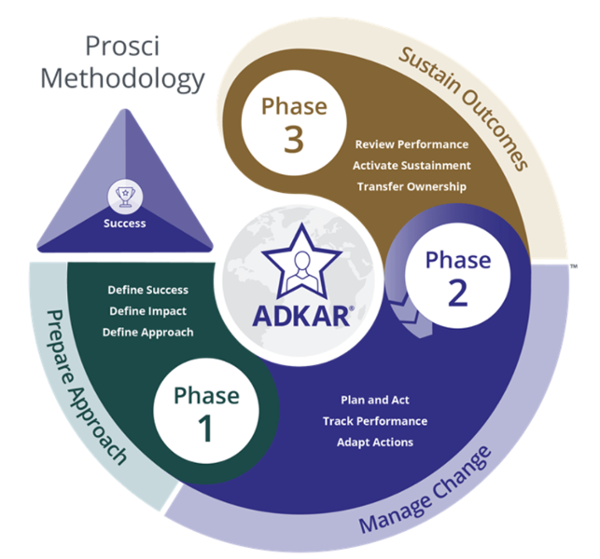
Interested in seeing CM in action? Here are some CM success stories you can learn from.
Prosci change management model
Change is tough, but Prosci makes it easier with practical frameworks to guide individuals and organizations through transitions.
The ADKAR Model focuses on individual change by taking people on a journey of:
- Awareness
- Desire
- Knowledge
- Ability
- Reinforcement
This model helps change practitioners make sense of change, develop plans, measure progress, and diagnose gaps, ensuring successful transitions.
The Prosci 3-Phase Process looks at the bigger organizational picture. It includes three phases:
- Phase 1 – Prepare Approach
- Phase 2 – Manage Change
- Phase 3 – Sustain Outcomes
Together, they help answer critical questions like "How do we define success?" and "How will we support our people?" and “How will we make sure the change sticks over time?”
Apply the Prosci ADKAR framework and 3-Phase Process to align personal development with organizational objectives, crafting a clear path to durable change.
"Depending on when the change managers are brought into the project, I often refer to the 3-Phase Process as a menu of sorts. During our initial discovery, I always conduct a PCT Assessment and Risk Assessment to determine how big or impactful the changes are, and whether the organization is set up in a healthy manner. From there, I refer to the actions within each of three phases to determine and recommend what might be appropriate for scaling to the project's needs. The tactics in the three phases serve as a great guideline for desired change management outcomes–whether it’s a light touch for smaller changes or more robust planning for large-scale initiatives–the 3-Phase Process clearly outlines a roadmap of tools, models and approaches that can be used to scale effectively."
—Brandon Richie, Engagement Leader, Prosci
Why Should an Organization Care
About Change Management?

Benchmarking studies conducted by Prosci found that 88% of participants with excellent change management met or exceeded objectives, compared to 13% of participants with poor change management.
Maximize change management
- Communicate clearly: Keep everyone informed to drive alignment and adoption.
- Reduce stress: Provide clear instructions to avoid confusion and ease the transition.
- Maintain productivity: Address problems quickly to keep your team on track.
- Improve morale: Ensure customers and staff are happy throughout the changes.
- Follow through: Deliver all planned changes to reap the full benefits.
- Cut risks: Avoid extra costs and protect your business from potential losses.
Effective change management ensures individual transitions that support project success and organizational agility. This makes change management beneficial and mission-critical for managing disruptive risks, enabling growth opportunities, and driving competitive advantage.
"During the rollout of an enterprise-wide purchasing/procurement system, change management was brought in too late, leading to low attendance, confusion, and resistance during training. The system was implemented with errors, offline reconciliation issues, and increased help desk tickets. The organization jumped right to the K in ADKAR (Knowledge). Bypassing A and D (Awareness and Desire) caused the affected groups to be unaware of the change, why it was necessary, what the benefits of using the system would be, or even timelines of the rollout. Further, the project team underestimated the breadth of the impacted groups and did not have the right representation to do a complete impact assessment."
Three big lessons learned:
1) Involve change management early in the project
2) Assess potential impacts thoroughly, leveraging holistic organizational knowledge
3) Follow ADKAR steps diligently and prioritize people's needs for successful adoption."
—Brandon Richie, Engagement Leader, Prosci
Marrying Organization Development and Change Management for a Change-Ready Future
After examining how company plans and individual readiness come together, we see that true change is about the journey, not just the final result. Using OD and CM is crucial for lasting success across all types of businesses.
Start merging these approaches to build a strong future for your company.
Now that you understand the important roles of OD and CM and how they make lasting change happen, it's time to act. Use Prosci methods centered around people to confidently guide your organization through the constant changes in the business world.
Equip your organization with Prosci resources—they're your free toolkit for fostering a culture of sustained growth and proactive adaptation, ensuring each member is an active contributor to the evolving narrative.
